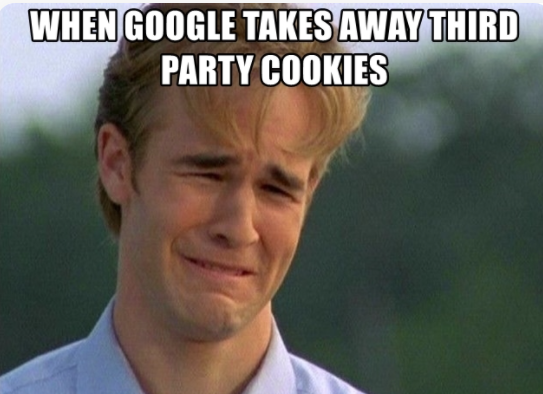Online advertising is about to change in a big way.
Last year, the search (and space and advertising) giant Google announced they plan to stop supporting third-party cookies that gather data about individual user behavior.
In March 2021, Director of Product Management, Ads Privacy and Trust (try saying that three times fast), David Temkin, announced Google plans to create a Privacy Sandbox that protects user anonymity while still (supposedly) providing advertisers and publishers with the data they need to target users effectively. Here's what he said:
"That’s why last year Chrome announced its intent to remove support for third-party cookies, and why we’ve been working with the broader industry on the Privacy Sandbox to build innovations that protect anonymity while still delivering results for advertisers and publishers."
For users worried about privacy, this sounds like a huge win.
For advertisers, it sounds like a huge blow.
The truth is? It's not quite either.
Here's what you need to know about Google's third-party cookie announcement, including what it means for the future of online advertising and how it impacts first-party data gathered from visitor tracking tools like Leadfeeder. (Spoiler: It doesn't.)
Note: Now is the time to try Leadfeeder. With Google's cookie ban, your regular source of leads might dwindle. Sign up for our free 14-day trial.
A quick history of cookies (no, not chocolate chip)
Cookies are a small piece of code stored on a user's device that tracks actions they take across the web. Cookies have been around since the early 90s, and have been pretty useful to both users and advertisers.
You've probably noticed items you search on Amazon or in Google Shopping show up later in Facebook ads — that's due to cookies. They can also save data you've entered into a form and track affiliate marketing campaigns.
As of 2021, 45 percent of websites use cookies to help better target users, deliver relevant ads, and, in some cases, personalize website experiences.

There are two main types of cookies: first-party and third-party. The difference between these two cookies is critical to understand what this change means for brands and for advertisers.
First-party cookies are used by each specific website to track actions you take on that website. For example, items you add to a cart, your location, or what type of content you read. These types of cookies don't track actions off of the website and are not impacted by Google's announcement.
Third-party cookies are placed by (you guessed it) a third party and allow advertisers to track users across the internet and target that user based on their preferences. These are the cookies Google is planning to eliminate.
Cookies generally expire after a few days or a few weeks, depending on the website and the type of cookie.
But there are also some drawbacks to cookies.
They often run afoul with privacy laws, like the GDPR.
They also aren't totally accurate — people share devices, research random topics for clients (✋), or make purchases on other devices or even in person.
Cookies can also put users and sites alike at risk for security leaks and hacking. Good times.
What exactly is Google's plan with third-party cookies in 2022?
Last year, Google announced they plan to stop supporting third-party cookies in the future. This year, they announced they have no plans to replace that ability in any capacity.
Google shared,
“Today, we’re making explicit that once third-party cookies are phased out, we will not build alternate identifiers to track individuals as they browse across the web, nor will we use them in our products.”
The change is likely in response to data privacy issues (like the Cambridge Analytica scandal) and the passage of GDPR and other related privacy laws.
They aren't alone.
Apple announced its iOS 14 (which went live in September) includes an Intelligent Tracking Prevention feature, which blocks cookies from tracking users across sites in Safari and other browsers on the iPhone.
Users (and governments) are starting to demand online privacy, and this change is a shift in that direction.
This means advertisers and tech platforms that rely on third-party cookie data need to change their approaches. But how?
What does Google's announcement about third-party cookies mean for marketing?
What does all this mean? (Cue anxiety).
Any time things change, it's hard not to feel like the sky is falling. (Like when Google stopped providing organic keywords or when people started working from home and made it harder for B2B companies to track leads.)
Here is what you need to know:
Yes, this will make it (a little) harder to track users across the web.
But it doesn't mean Google will stop tracking users and it doesn't mean you won't be able to target ads.
There are still several ways for Google to track user activity. Google is saying they will pour all that data into a technology called FLoC that will aggregate and anonymize the data.
"Our latest tests of FLoC show one way to effectively take third-party cookies out of the advertising equation and instead hide individuals within large crowds of people with common interests."
This means brands can still track, for example, 38-year olds who live in urban areas and watch Star-Trek, but they can't track individuals specifically.
This change also doesn't impact first-party data, like what Leadfeeder uses. That's because we use data from users on your website, including IP address intent and reverse DNS.
Rest assured, your Leadfeeder data is safe and sound.

But, there's a good chance you rely on other tools that use third-party cookies. Let's talk about how to adjust your strategies for a third-party cookie-less world.
Your post-cookie world action plan: 4 strategies to implement today
There's no doubt that cookies are an important sales and marketing tool. They help brands better understand their audiences and deliver personalized content and ads.
So, what do we do when that data is gone?
Besides cry, I mean.

Here are four strategies to help your business thrive in a post-third-party cookie world, including actionable steps you can put into place today.
The future of marketing is in first-party data
So, we can no longer rely on third-party data to drive marketing and sales strategies.
I'd argue that’s actually a good thing.
Why? Because third-party data was never all that great, to begin with. 💅
Here's why:
Third-party data is data you pay to access from outside sources. It's been valuable in the past, but there are several issues with this type of data, including:
The platform you buy data from often didn't collect that data themselves--it might pass through two or three sources before you get access to it. Which means you have no idea where it came from.
It's publicly accessible, which means all your competitors have access to the same data.
It is usually high-volume, which means companies either spend a lot of time or money sorting through massive amounts of data to find something that is useful.
First-party data, on the other hand, is customer data you collect, with consent, about individuals who interact with your brand. It can be collected from a pixel that tracks website behavior, a CRM, or even customer surveys.
It allows you to see exactly how your audience interacts with your brand. First-party data is:
Cheaper; you don't have to buy the data from anyone.
Exclusive to your brand, so your competitors don't have it.
More accurate, because it's from individuals who interact with your business.
As an added bonus, you know where the data came from and can ensure all privacy laws and regulations were followed.
(There is also second-party data, but it's used much less often.)
As third-party cookie data becomes less available, brands need to gather more first-party data by building communities and asking for consent to gather data — which most consumers are happy to provide.
As an added bonus, first-party data can be combined with aggregate data from Google and other platforms to understand how users act across multiple platforms.
Action plan: Use a tool, like Leadfeeder, to start gathering and leveraging first-party data. Google isn't getting rid of third-party cookies until next year, but you need to be prepared.
Programmatic buying will become the new norm
Programmatic buying is the use of automated tech to purchase advertising space, as opposed to the manual process most brands use today.
Programmatic buying relies on technology and is designed to make purchasing paid ads cheaper and more efficient.
It's not actually new — Google's automated bid strategy and Smart Bidding have been around for a few years, though most purist marketers avoided them. Facebook has also offered programmatic buying for several years.
In the past, programmatic buying was generally used by small business owners or marketers who didn't want or need to dig into the details of paid ads.
Most marketers (especially those in the B2B space) are used to being hands-on when buying and bidding on digital paid ads.
Don't worry; the robots aren't completely taking over.

Programmatic buying is automated, but you'll still have some control.
Here are a few benefits of programmatic buying;
More control: Programmatic buying actually offers more transparency and control because businesses can see exactly what type of consumers see their ads.
It's faster: Programmatic bidding occurs in real-time, so you can easily make adjustments on the fly.
Real-time data: Rather than waiting days or weeks to see ad data, you'll be able to see what happens in real-time. What marketer doesn't want more real-time data??
It is likely to be cheaper: With better transparency and real-time data, programmatic buying is more efficient because it limits human error.
Action Plan: Start learning more about programmatic data so you can implement it as soon as possible. This guide is a good place to start.
Produce content that appeals to specific demographics
The truth is, users like having a personalized web experience - 80 percent of consumers say they are more likely to shop with brands that offer personalized experiences.
Even more telling, 90 percent of consumers are willing to share behavioral data for a better brand experience.
Rather than creating broad content that appeals to a wide range of users, brands need to focus on creating a personalized website experience — including providing personalized content.
Here's how this might look in practice:
Rather than suggesting the same ebook to all site visitors, a brand might use first-party data to suggest a marketing ebook to users who indicate they are in marketing and a sales ebook to users in sales.
Or, a site might show users that land on a web page after searching for "health" related letters one type of content and users that searched for "electronics" another type of content.
Content personalization can help brands:
Increase time on page by offering content users are likely to be interested in.
Address specific pain points based on a user's industry or interests.
Better understand who their customers are and where they are falling off in the funnel.
By leveraging first-party data and programmatic buying, brands are actually going to be better able to target users — even without third-party cookie data.
Action plan: Create personalized content for different demographics and lean into website personalization.
Contextual targeting
These days, it's hard to imagine not serving an ad based on behavior — many businesses use actions like reading a blog post, clicking on a landing page link, or viewing a product page to target users who are likely to convert.
But behavioral targeting isn't the only way to target ads. The end of third-party cookies is driving another type of targeting — called contextual targeting.
Contextual targeting is the practice of placing ads based on the type of content on a page. For example, in a New York Times article about LeBron James, there is an ad for yoga pants. Which, of course, is related to sports.

There are plenty of benefits of contextual ads, such as:
It's easier to do and costs less: Since you aren't tracking user behavior, you don't need access to the tools that gather and analyze data. This makes it a more cost-effective targeting strategy.
It isn't impacted by privacy regulations: Placing ads based on content context doesn't require tracking your users at all, so you won't have to worry about GDPR and other privacy laws that might pass in the future.
It's less creepy: Users who might be turned off by highly targeted ads are less likely to mind contextual targeting because it's relevant to the content they are reading.
It can be more relevant: Have you ever clicked on one product and then seen ads for it for weeks? Maybe it was a friend showing something they purchased or research for a client--either way, you had no intention of ever purchasing that item. (Or maybe you did but on a mobile device.) Contextual targeting avoids this issue by targeting users based on the content they are consuming right now. (Which is another reason to create content that appeals to different demographics!)
You can also use real-time context-based signals to make bidding decisions for programmatic buying.
Action plan: Move at least some of your ad spend from behavioral targeting to contextual targeting.
Third-party cookies are going away; your ability to target users isn't
Google's decision to stop supporting third-party cookies is going to change the way sales and marketing teams work, but it won't have a devastating impact.
Instead of relying on dodgy third-party data, it's time to focus on strategies like first-party data, programmatic buying, creating more personalized content, and using contextual targeting.
Note: Want to see what companies are visiting your website and what they do when they get there? Sign up to try Leadfeeder free for 14 days and find out.
Now that you're here
Leadfeeder is a tool that shows you companies that visit your website. Leadfeeder generates new leads, offers insight on your customers and can help you increase your marketing ROI.
If you liked this blog post, you'll probably love Leadfeeder, too.
Sign up







